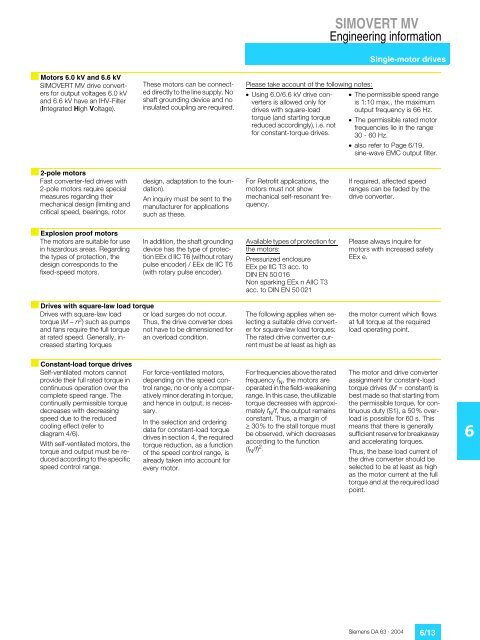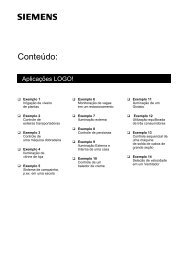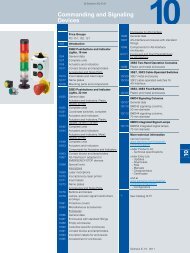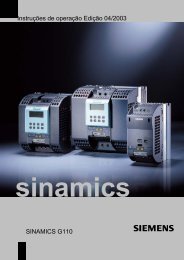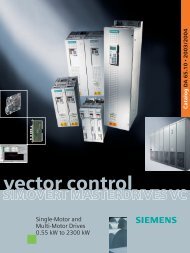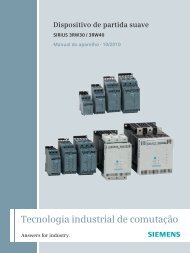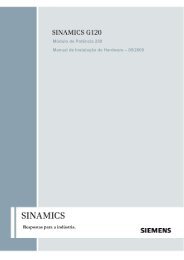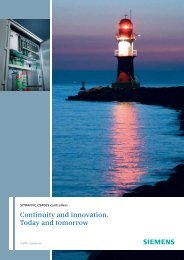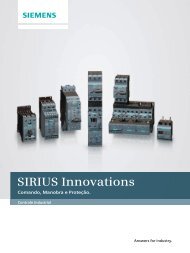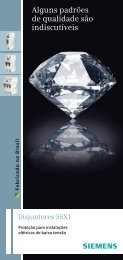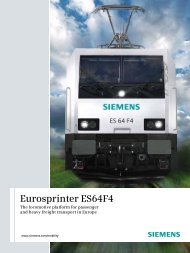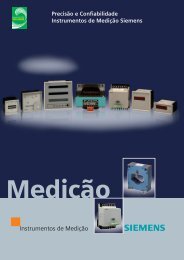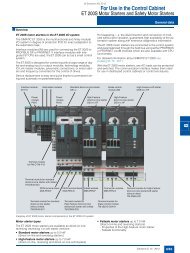SIMOVERT MV Medium-Voltage Drives 660 kVA to 9100 ... - Industry
SIMOVERT MV Medium-Voltage Drives 660 kVA to 9100 ... - Industry
SIMOVERT MV Medium-Voltage Drives 660 kVA to 9100 ... - Industry
You also want an ePaper? Increase the reach of your titles
YUMPU automatically turns print PDFs into web optimized ePapers that Google loves.
Mo<strong>to</strong>rs 6.0 kV and 6.6 kV<strong>SIMOVERT</strong> <strong>MV</strong> drive convertersfor output voltages 6.0 kVand 6.6 kV have an IHV-Filter(Integrated High <strong>Voltage</strong>).These mo<strong>to</strong>rs can be connecteddirectly <strong>to</strong> the line supply. Noshaft grounding device and noinsulated coupling are required.Please take account of the following notes:¦ Using 6.0/6.6 kV drive convertersis allowed only fordrives with square-load<strong>to</strong>rque (and starting <strong>to</strong>rquereduced accordingly), i.e. notfor constant-<strong>to</strong>rque drives.<strong>SIMOVERT</strong> <strong>MV</strong>Engineering informationSingle-mo<strong>to</strong>r drives¦ The permissible speed rangeis 1:10 max., the maximumoutput frequency is 66 Hz.¦ The permissible rated mo<strong>to</strong>rfrequencies lie in the range30 - 60 Hz.¦ also refer <strong>to</strong> Page 6/19,sine-wave EMC output filter.2-pole mo<strong>to</strong>rsFast converter-fed drives with2-pole mo<strong>to</strong>rs require specialmeasures regarding theirmechanical design (limiting andcritical speed, bearings, ro<strong>to</strong>rdesign, adaptation <strong>to</strong> the foundation).An inquiry must be sent <strong>to</strong> themanufacturer for applicationssuch as these.For Retrofit applications, themo<strong>to</strong>rs must not showmechanical self-resonant frequency.If required, affected speedranges can be faded by thedrive converter.Explosion proof mo<strong>to</strong>rsThe mo<strong>to</strong>rs are suitable for usein hazardous areas. Regardingthe types of protection, thedesign corresponds <strong>to</strong> thefixed-speed mo<strong>to</strong>rs.In addition, the shaft groundingdevice has the type of protectionEEx d IIC T6 (without rotarypulse encoder) / EEx de IIC T6(with rotary pulse encoder).Available types of protection forthe mo<strong>to</strong>rs:Pressurized enclosureEEx pe IIC T3 acc. <strong>to</strong>DIN EN 50 016Non sparking EEx n AIIC T3acc. <strong>to</strong> DIN EN 50 021Please always inquire formo<strong>to</strong>rs with increased safetyEEx e.<strong>Drives</strong> with square-law load <strong>to</strong>rque<strong>Drives</strong> with square-law load or load surges do not occur.<strong>to</strong>rque (M ~ n 2 ) such as pumps Thus, the drive converter doesand fans require the full <strong>to</strong>rque not have <strong>to</strong> be dimensioned forat rated speed. Generally, increasedstartingan overload condition.<strong>to</strong>rquesThe following applies when selectinga suitable drive converterfor square-law load <strong>to</strong>rques:The rated drive converter currentmust be at least as high asthe mo<strong>to</strong>r current which flowsat full <strong>to</strong>rque at the requiredload operating point.Constant-load <strong>to</strong>rque drivesSelf-ventilated mo<strong>to</strong>rs cannotprovide their full rated <strong>to</strong>rque incontinuous operation over thecomplete speed range. Thecontinually permissible <strong>to</strong>rquedecreases with decreasingspeed due <strong>to</strong> the reducedcooling effect (refer <strong>to</strong>diagram 4/6).With self-ventilated mo<strong>to</strong>rs, the<strong>to</strong>rque and output must be reducedaccording <strong>to</strong> the specificspeed control range.For force-ventilated mo<strong>to</strong>rs,depending on the speed controlrange, no or only a comparativelyminor derating in <strong>to</strong>rque,and hence in output, is necessary.In the selection and orderingdata for constant-load <strong>to</strong>rquedrives in section 4, the required<strong>to</strong>rque reduction, as a functionof the speed control range, isalready taken in<strong>to</strong> account forevery mo<strong>to</strong>r.For frequencies above the ratedfrequency f N , the mo<strong>to</strong>rs areoperated in the field-weakeningrange. In this case, the utilizable<strong>to</strong>rque decreases with approximatelyf N /f, the output remainsconstant. Thus, a margin of˜ 30% <strong>to</strong> the stall <strong>to</strong>rque mustbe observed, which decreasesaccording <strong>to</strong> the function(f N /f) 2 .The mo<strong>to</strong>r and drive converterassignment for constant-load<strong>to</strong>rque drives (M =constant) isbest made so that starting fromthe permissible <strong>to</strong>rque, for continuousduty (S1), a 50% overloadis possible for 60 s. Thismeans that there is generallysufficient reserve for breakawayand accelerating <strong>to</strong>rques.Thus, the base load current ofthe drive converter should beselected <strong>to</strong> be at least as highas the mo<strong>to</strong>r current at the full<strong>to</strong>rque and at the required loadpoint.6Siemens DA 63 · 2004 6/13


